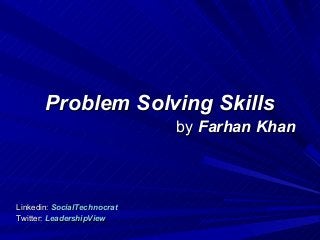Problem solving skills by farhan khan
•Télécharger en tant que PPT, PDF•
5 j'aime•1,942 vues
Signaler
Partager
Signaler
Partager

Recommandé
Recommandé
Contenu connexe
En vedette
En vedette (20)
Product Design Trends in 2024 | Teenage Engineerings

Product Design Trends in 2024 | Teenage Engineerings
How Race, Age and Gender Shape Attitudes Towards Mental Health

How Race, Age and Gender Shape Attitudes Towards Mental Health
AI Trends in Creative Operations 2024 by Artwork Flow.pdf

AI Trends in Creative Operations 2024 by Artwork Flow.pdf
Content Methodology: A Best Practices Report (Webinar)

Content Methodology: A Best Practices Report (Webinar)
How to Prepare For a Successful Job Search for 2024

How to Prepare For a Successful Job Search for 2024
Social Media Marketing Trends 2024 // The Global Indie Insights

Social Media Marketing Trends 2024 // The Global Indie Insights
Trends In Paid Search: Navigating The Digital Landscape In 2024

Trends In Paid Search: Navigating The Digital Landscape In 2024
5 Public speaking tips from TED - Visualized summary

5 Public speaking tips from TED - Visualized summary
Google's Just Not That Into You: Understanding Core Updates & Search Intent

Google's Just Not That Into You: Understanding Core Updates & Search Intent
The six step guide to practical project management

The six step guide to practical project management
Beginners Guide to TikTok for Search - Rachel Pearson - We are Tilt __ Bright...

Beginners Guide to TikTok for Search - Rachel Pearson - We are Tilt __ Bright...
Problem solving skills by farhan khan
- 1. Problem Solving Skills by Farhan Khan Linkedin: SocialTechnocrat Twitter: LeadershipView
- 2. Definition of Problem Solving Problem solving refers to a state of desire for reaching a definite 'goal' from a present condition "Problems are only opportunities in work clothes." – Henry Kaiser (American industrialist)
- 3. Four Basic Step There are four basic steps in problem solving: Defining the problem - The key to a good problem definition is ensuring that you deal with the real problem – not its symptoms. Use 5W2H Method Creativity (Generating alternatives) Decision Making (Evaluating & Selecting alternatives) Project Management (Implementing solutions)
- 4. Help DEFINING PROBLEM using 5W2H Methodology Who What Why Where When How Much How Often
- 5. Help your CREATIVITY with 6 Thinking Hats of Edward Debono The Blue Hat 'Wearing' the red hat, stands for you look at problems process control The yellow hat using intuition helps you to the Green Hat think positively Using black hat stands for thinking, look at creativity all the bad points of the decision With this thinking hat you focus on the data available.
- 6. Help your DECISION MAKING with PEST & SWOT Analysis PEST Analysis helps you understand the Political, Economic, Social, and Technological changes that will shape your business environment SWOT Analysis help you understand the Strengths, Weaknesses, Opportunities & Threats for your business decision.
- 7. Problem Solving Methodologies Eight Disciplines (8D) GROW Model
- 8. Eight Disciplines (8D) – 0: Plan: Plan for solving the problem and determine the prerequisites. – D1: Use a Team: Establish a team of people with product/process knowledge. – D2: Define and describe the Problem: Specify the problem by identifying in quantifiable terms the who, what, where, when, why, how, and how many (5W2H) for the problem. – D3: Develop Interim Containment Plan; Implement and verify Interim Actions : Define and implement containment actions to isolate the problem from any customer. – D4: Determine, Identify, and Verify Root Causes and Escape Points : Identify all applicable causes that could explain why the problem has occurred. Also identify why the problem has not been noticed at the time it occurred. All causes shall be verified or proved, not determined by fuzzy brainstorming. One can use five whys or Ishikawa diagramsto map causes against the effect or problem identified. – D5: Choose and Verify Permanent Corrections (PCs) for Problem/Non Conformity: Through pre-production programs quantitatively confirm that the selected correction will resolve the problem for the customer. (Verify the correction will actually solve the problem) – D6: Implement and Validate Corrective Actions: Define and Implement the best corrective actions. – D7: Take Preventive Measures: Modify the management systems, operation systems, practices, and procedures to prevent recurrence of this and all similar problems. – D8: Congratulate Your Team: Recognize the collective efforts of the team. The team needs to be formally thanked by the organization.
- 9. GROW Model G: Goal: This is the end point, where you wants to be. The goal has to be defined in such a way that it is very clear to you when they have achieved it. R: Reality: The Current Reality is where you is now. What are the issues, the challenges, how far are they away from their goal? O: Obstacles: There will be Obstacles stopping you getting from where they are now to where they want to go. If there were no Obstacles you would already have reached their goal. O: Options: Once Obstacles have been identified, you needs to find ways of dealing with them if they are to make progress. These are the Options. W: Way Forward: The Options then need to be converted into action steps which will take you to their goal. These are the Way Forward.
- 10. Thank you
